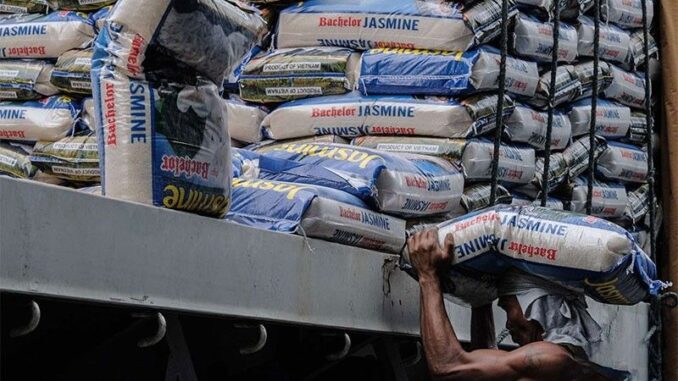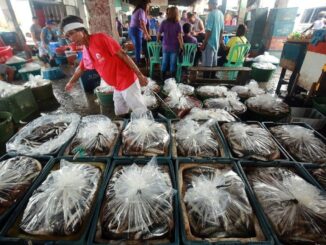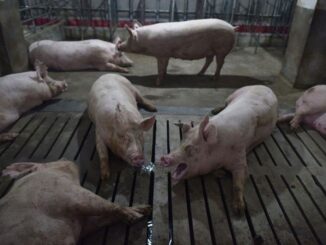
MANILA, Philippines — A ranking official of the Department of Agriculture (DA) yesterday reported a P3-per-kilo drop in the retail price of imported rice amid the implementation of Executive Order 62, which lowered tariff from 35 percent to only 15 percent.
In an interview with The STAR, Agriculture Assistant Secretary and spokesman Arnel de Mesa yesterday claimed the cost of imported rice is now cheaper compared to the price of local rice.
“Regular milled rice is now cheaper by P3 per kilo, at least in the low range. On the high range, imported rice is cheaper by P1 (per kilo),” De Mesa said.
He also said that based on the DA monitoring in Metro Manila markets, the retail price of imported regular rice ranged between P42 and P50 per kilo, while that of local regular milled rice is from P45 to P51 per kilo.
“The (P42 to P45 imported) regular milled (rice) is available in Guadalupe (Makati City), La Huerta (Parañaque), Malabon, Muntinlupa and Taguig. These are imported,” De Mesa added.
Earlier, farmers’ group Samahang Industriya ng Agrikultura (SINAG) chairman Rosendo So said the government lost at least P5.2 billion in tariff collection amid the implementation of EO 62, adding that the 15-percent tariff on imported rice failed to bring down the retail prices of the staple.
President Marcos issued EO 62 to slash the 35-percent tariff on imported rice to 15 percent in an effort to bring down the cost of the staple in the country. The measure took effect on July 7.
So said the country’s imported rice from January 2024 to September 2024 totaled 3.1 million metric tons. “From July 4, rice imports of 2.3 million MT, we already imported 800,000 MT under the lower tariff. We already lost P5.2 billion in tariff collection.”
Stocks at 4-month low
Although the country’s rice stocks in August rose by 14 percent on an annual basis on the back of higher inventory recorded by commercial entities and the National Food Authority (NFA), nationwide stocks also fell to their lowest level in four months.
Latest Philippine Statistics Authority (PSA) report showed that nationwide rice inventory, as of Aug. 1, rose by 14.4 percent to 1.867 million MT from 1.632 million MT recorded in the same period a year ago.
The PSA data also showed that the rice stocks in commercial entities and NFA expanded while the stocks held by households contracted on an annual basis.
“Month-on-month, the volume of rice stocks inventory recorded a decrement of 14.2 percent from the previous month’s inventory of 2.18 million MT,” the PSA said.
PSA said the commercial sector accounted for 62.4 percent of the country’s total rice stocks while households contributed 29.6 percent and NFA contributed 8.1 percent.
Rice inventory in commercial entities reached 1.165 million MT, about 23.3 percent higher than the 945,100 MT recorded last year.
NFA rice stocks nearly tripled during the reference period to 150,739 MT from 50,948 MT, based on PSA data.
Household rice stocks, meanwhile, contracted 13.3 percent year-on-year to 551,898 MT from 636,406 MT, according to the PSA.
“In comparison to the July 2024 rice stocks levels, decrements were noted from the households by 21.9 percent, as well as in the commercial sector by 12.0 percent… Rice stocks inventory from the NFA depositories increased by 2.4 percent,” the PSA said.
Meanwhile, Speaker Martin Romualdez urged the DA and other concerned agencies to expand the outlets for cheaper rice to make sure more Filipinos benefit from it.
Romualdez said DA should extend the reach of Kadiwa centers, which sell rice at only P29 per kilo, to allow more consumers to access cheap rice.
“Just like what the President said in his SONA, the success of the economy is nothing if this will not be felt by the people. Affordable rice is the goal of the President for each and every Filipino family,” Romualdez said during the recent launch of the Bagong Bayaning Magsasaka Rice program, a partnership between the National Irrigation Authority and irrigation association members.
He added the DA should set up Kadiwa centers in every market across the country to “better serve Filipino consumers.” — Sheila Crisostomo, Jasper Emmanuel Arcalas





Be the first to comment